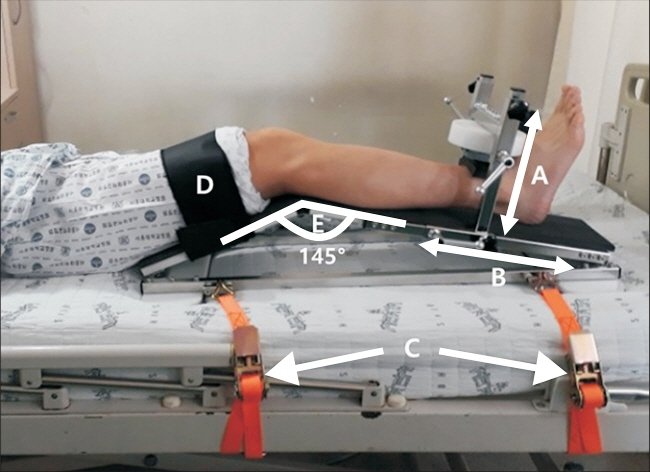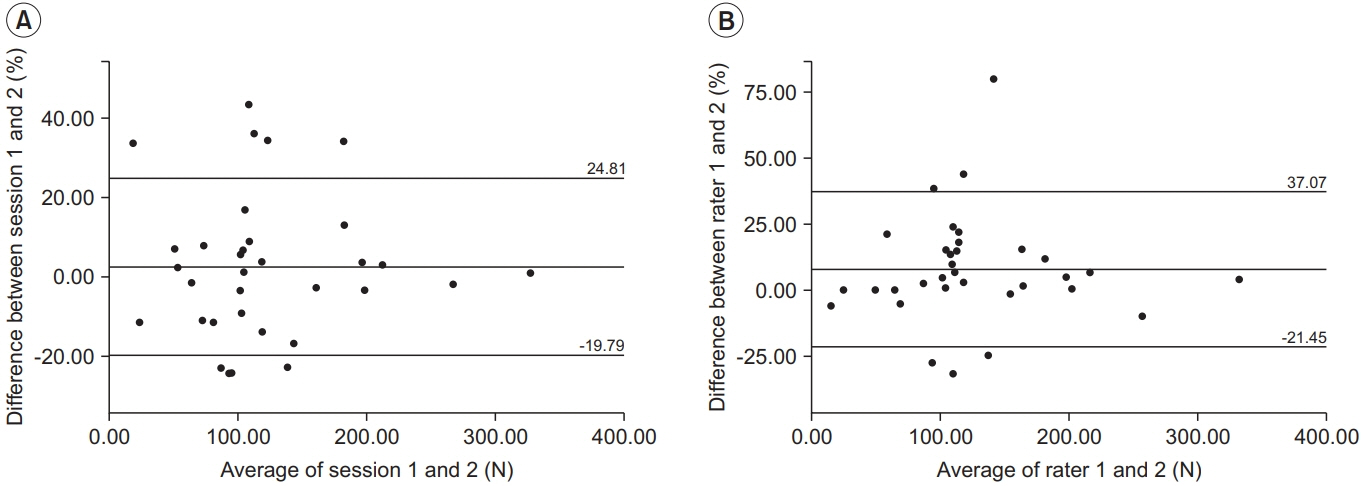Ann Rehabil Med.
2020 Dec;44(6):502-509. 10.5535/arm.20056.
Knee Extensor Strength Measurement in Patients With Limited Physical Activity Using a Supine Dynamometer Anchoring Frame
- Affiliations
-
- 1Department of Rehabilitation Medicine, Seoul National University Hospital, Seoul National University College of Medicine, Seoul, Korea
- 2Department of Rehabilitation Medicine, Seoul National University Hospital, Seoul, Korea
- KMID: 2510817
- DOI: http://doi.org/10.5535/arm.20056
Abstract
Objective
To investigate the reliability of knee extensor strength measurements using a supine hand-held dynamometer (HHD) anchoring frame in patients with limited physical activity. Although an HHD is suitable for bedside use, its inter-rater reliability is low because measurements can be influenced by tester strength.
Methods
Maximal knee extensor isometric strength was measured using an HHD anchored to the supine frame. Three trials of three maximal contractions were assessed by two raters.
Results
A total of 33 inpatients who were non-ambulatory due to acute illness participated in the study. The intraclass correlation coefficients were 0.974 (inter-rater) and 0.959 (intra-rater). The minimal detectable changes in intra- and inter-observer measurements were 29.46 N (24.10%) and 36.73 N (29.26%), respectively. The limits of agreement ranged from -19.79% to 24.81% for intra-rater agreement and from -21.45% to 37.07% for inter-rater agreement.
Conclusion
The portable dynamometer anchoring system can measure the isometric strength of the knee extensor reliably in the supine position, and could be used for measurements in patients who have difficulty visiting the laboratory and maintaining a seated posture.
Figure
Reference
-
1. Vanpee G, Hermans G, Segers J, Gosselink R. Assessment of limb muscle strength in critically ill patients: a systematic review. Crit Care Med. 2014; 42:701–11.2. Newman AB, Kupelian V, Visser M, Simonsick EM, Goodpaster BH, Kritchevsky SB, et al. Strength, but not muscle mass, is associated with mortality in the health, aging and body composition study cohort. J Gerontol A Biol Sci Med Sci. 2006; 61:72–7.
Article3. Herridge MS, Tansey CM, Matte A, Tomlinson G, Diaz-Granados N, Cooper A, et al. Functional disability 5 years after acute respiratory distress syndrome. N Engl J Med. 2011; 364:1293–304.
Article4. Durstine JL, Painter P, Franklin BA, Morgan D, Pitetti KH, Roberts SO. Physical activity for the chronically ill and disabled. Sports Med. 2000; 30:207–19.
Article5. Bohannon RW. Manual muscle testing: does it meet the standards of an adequate screening test? Clin Rehabil. 2005; 19:662–7.
Article6. Hermans G, Gosselink R. Should we abandon manual muscle strength testing in the ICU? Crit Care. 2011; 15:127.
Article7. Stark T, Walker B, Phillips JK, Fejer R, Beck R. Handheld dynamometry correlation with the gold standard isokinetic dynamometry: a systematic review. PM R. 2011; 3:472–9.
Article8. Kolber MJ, Cleland JA. Strength testing using handheld dynamometry. Phys Ther Rev. 2005; 10:99–112.
Article9. Kim WK, Kim DK, Seo KM, Kang SH. Reliability and validity of isometric knee extensor strength test with hand-held dynamometer depending on its fixation: a pilot study. Ann Rehabil Med. 2014; 38:84–93.
Article10. Lu TW, Chien HL, Chang LY, Hsu HC. Enhancing the examiner’s resisting force improves the validity of manual muscle strength measurements: application to knee extensors and flexors. J Strength Cond Res. 2012; 26:2364–71.11. Koblbauer IF, Lambrecht Y, van der Hulst ML, Neeter C, Engelbert RH, Poolman RW, et al. Reliability of maximal isometric knee strength testing with modified hand-held dynamometry in patients awaiting total knee arthroplasty: useful in research and individual patient settings? A reliability study. BMC Musculoskelet Disord. 2011; 12:249.
Article12. Gagnon D, Nadeau S, Gravel D, Robert J, Belanger D, Hilsenrath M. Reliability and validity of static knee strength measurements obtained with a chair-fixed dynamometer in subjects with hip or knee arthroplasty. Arch Phys Med Rehabil. 2005; 86:1998–2008.
Article13. Sung KS, Yi YG, Shin HI. Reliability and validity of knee extensor strength measurements using a portable dynamometer anchoring system in a supine position. BMC Musculoskelet Disord. 2019; 20:320.
Article14. Babault N, Pousson M, Michaut A, Van Hoecke J. Effect of quadriceps femoris muscle length on neural activation during isometric and concentric contractions. J Appl Physiol (1985). 2003; 94:983–90.
Article15. Martin HJ, Yule V, Syddall HE, Dennison EM, Cooper C, Aihie Sayer A. Is hand-held dynamometry useful for the measurement of quadriceps strength in older people?: a comparison with the gold standard Bodex dynamometry. Gerontology. 2006; 52:154–9.16. Weir JP. Quantifying test-retest reliability using the intraclass correlation coefficient and the SEM. J Strength Cond Res. 2005; 19:231–40.
Article17. Koo TK, Li MY. A guideline of selecting and reporting intraclass correlation coefficients for reliability research. J Chiropr Med. 2016; 15:155–63.
Article18. Terwee CB, Mokkink LB, Knol DL, Ostelo RW, Bouter LM, de Vet HC. Rating the methodological quality in systematic reviews of studies on measurement properties: a scoring system for the COSMIN checklist. Qual Life Res. 2012; 21:651–7.
Article19. Denegar CR, Ball DW. Assessing reliability and precision of measurement: an introduction to intraclass correlation and standard error of measurement. J Sport Rehabil. 1993; 2:35–42.
Article20. Portney LG, Watkins MP. Foundations of clinical research: application to practice. 3rd ed. Upper Saddle River, NJ: Pearson/Prentice Hall;2009.21. Ludbrook J. Confidence in Altman-Bland plots: a critical review of the method of differences. Clin Exp Pharmacol Physiol. 2010; 37:143–9.
Article22. Giavarina D. Understanding Bland Altman analysis. Biochem Med (Zagreb). 2015; 25:141–51.
Article23. Knols RH, Aufdemkampe G, de Bruin ED, Uebelhart D, Aaronson NK. Hand-held dynamometry in patients with haematological malignancies: measurement error in the clinical assessment of knee extension strength. BMC Musculoskelet Disord. 2009; 10:31.
Article24. Jackson SM, Cheng MS, Smith AR Jr, Kolber MJ. Intrarater reliability of hand held dynamometry in measuring lower extremity isometric strength using a portable stabilization device. Musculoskelet Sci Pract. 2017; 27:137–41.
Article25. Kean CO, Birmingham TB, Garland SJ, Bryant DM, Giffin JR. Minimal detectable change in quadriceps strength and voluntary muscle activation in patients with knee osteoarthritis. Arch Phys Med Rehabil. 2010; 91:1447–51.
Article26. Noorizadeh Dehkordi S, Talebian S, Olyaei G, Montazeri A. Reliability of isokinetic normalized peak torque assessments for knee muscles in post-stroke hemiparesis. Gait Posture. 2008; 27:715–8.
Article27. Machado Rodrigues F, Demeyer H, Hornikx M, Camillo CA, Calik-Kutukcu E, Burtin C, et al. Validity and reliability of strain gauge measurement of volitional quadriceps force in patients with COPD. Chron Respir Dis. 2017; 14:289–97.
Article28. Baldwin CE, Paratz JD, Bersten AD. Muscle strength assessment in critically ill patients with handheld dynamometry: an investigation of reliability, minimal detectable change, and time to peak force generation. J Crit Care. 2013; 28:77–86.
Article29. Rousseau AF, Kellens I, Freycenon G, Dardenne N, Bruyere O, Damas P, et al. Highly standardized quadriceps dynamometry of critically ill adults at bedside: a step towards individualized rehabilitation. Acta Anaesth Belg. 2018; 69:159–64.30. LeBlanc AD, Schneider VS, Evans HJ, Pientok C, Rowe R, Spector E. Regional changes in muscle mass following 17 weeks of bed rest. J Appl Physiol (1985). 1992; 73:2172–8.
Article31. Mulder ER, Stegeman DF, Gerrits KH, Paalman MI, Rittweger J, Felsenberg D, et al. Strength, size and activation of knee extensors followed during 8 weeks of horizontal bed rest and the influence of a countermeasure. Eur J Appl Physiol. 2006; 97:706–15.32. Moxley Scarborough D, Krebs DE, Harris BA. Quadriceps muscle strength and dynamic stability in elderly persons. Gait Posture. 1999; 10:10–20.
Article33. Seymour JM, Ward K, Sidhu PS, Puthucheary Z, Steier J, Jolley CJ, et al. Ultrasound measurement of rectus femoris cross-sectional area and the relationship with quadriceps strength in COPD. Thorax. 2009; 64:418–23.
Article34. Grimm A, Teschner U, Porzelius C, Ludewig K, Zielske J, Witte OW, et al. Muscle ultrasound for early assessment of critical illness neuromyopathy in severe sepsis. Crit Care. 2013; 17:R227.
Article
- Full Text Links
- Actions
-
Cited
- CITED
-
- Close
- Share
- Similar articles
-
- Reliability and Validity of Isometric Knee Extensor Strength Test With Hand-Held Dynamometer Depending on Its Fixation: A Pilot Study
- Reliability and Validity of a New Method for Isometric Back Extensor Strength Evaluation Using A Hand-Held Dynamometer
- Effects of Repetitive Sit to Stand Training on the Knee Extensor Strength and Walking Ability in Subject with Total Knee Replacement Patients
- Influence of Head-Neck Rotation on Elbow Flexor and Extensor Muscle Activity and Strength in Normal Adults
- Relationship of C-Reactive Protein to Muscle Strength in Elderly Men: A Cross-Sectional Study in Korea




